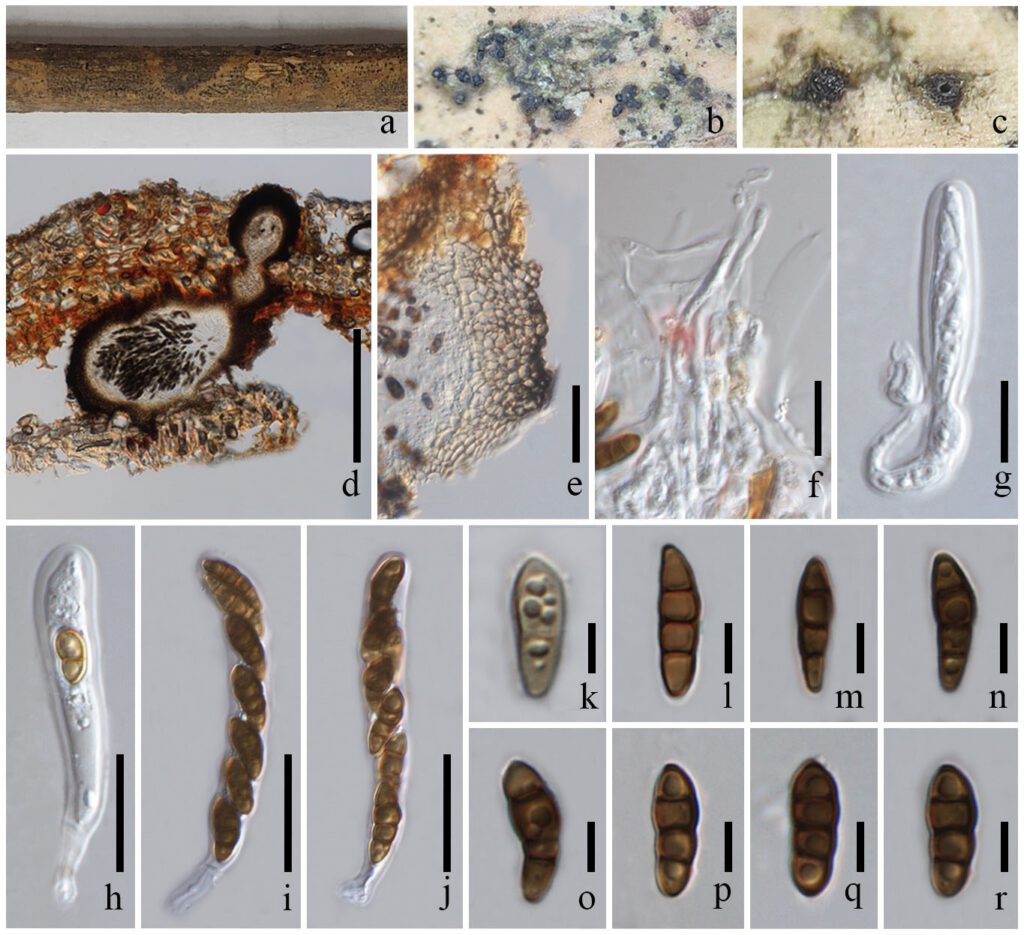Nigrograna heveae R.F. Xu, K.D. Hyde & Tibpromma sp. nov
MycoBank number: MB; Index Fungorum number: IF; Facesoffungi number: FoF 12908; Fig. Y
Saprobic on rubber tree of Hevea brasiliensis. Sexual morph: Ascomata 203–460 × 146–200 μm (x̅ = 369 × 166μm, n = 5), immersed, under to clypeus, some inconspicuous on host surface, some can see small bumps, solitary, uniloculate, dark brown, globose or ellipsoid, neck. Neck 192–206 μm high, consists of two parts, first a small subglobose with 75–85 μm wide, second a large globose with 100–105 μm wide, brown to dark brown. Peridium 26–63 μm wide, comprising dark-brown to dark of textura angularis. Hamathecium 2–3 μm wide, branched, hyaline, paraphyses. Asci 45–70 × 7–10 μm (x̅ = 57 × 8μm, n = 10), 1–8-spored, bitunicate, cylindrical to clavate, club shape or furcated, apically rounded, thick-walled. Ascospores 10–20 × 3–5μm (x̅ = 14 × 4 μm, n= 30), inequilateral, 0-3-septate, slightly rounded or pointed at both ends, constricted at the central septum, yellow-brown to brown with age, guttulate, thick-walled. Asexual morph: Undetermined.
Culture characteristics: Ascospores germinating on PDA within 24 hours, circular, entire edge, raised, floppy, grey to taupe, dark brown reverse.
Material examined: CHINA, Yunnan Province, Pu’er, on a Hevea brasiliensis (rubber) tree, 16 September 2021, Ruifang Xu, XPER-18, (ZHKU 22-0152, holotype); ex-type living cultures ZHKUCC 22-0284.
GenBank number: ITS: ***, LSU: ***, SSU: ***, RPB2: ***, TEF: ***
Notes: NCBI BLASTn searches of our new isolate (ZHKUCC 22-0284) sequences showed 94.06% similarity to N. cangshanensis (MFLUCC 15-0253: NR155486) in ITS sequence; LSU and TEF sequence showed 99.30% and 96.65% similarities to N. locuta-pollinis (LC11690: MF939614); and SSU and RPB2 sequence showed 92.93% and 87.79% similarities to N. obliqua (CBS141475: KX650579). Nigrograna heveae is phylogenetically closely related to N. asexualis, with good statistical support (100% ML/ 1.00 BYPP, Fig. X). The sequence comparisons between our strain and N. asexualis (ZHKUCC 22-0214) show 17 bp (3.65%) differences in 465 bp fragment of ITS, 115 bp (11.28%) differences in 1019 bp fragment of RPB2 and 48 bp (5%) differences in 960 bp fragment of TEF1 (Lu et al. 2022). According to Jeewon and Hyde (2016), a minimum of > 1.5% nucleotide differences in the ITS regions is indicative of a new species. Nigrograna asexualis was documented as a saprobic asexual morph on coffee from Yunnan Province and our taxon was also found in the same location. Unfortunately, the sexual morph is not available for N. asexualis to compare with our novel taxon. Based on morphology and phylogenetic analyses, we introduce N. heveae as a new species.

Fig. Y Nigrograna heveae (ZHKU 22-0152, holotype) a–c Appearance of ascostromata on the host substrate. d Section of an ascoma. e Peridium. f Paraphyses. g–j Asci. k–r Ascospores. Scale bars: d = 200 μm, e = 30 μm, f,h,i = 20 μm, g = 10 μm, k–l = 5 μm.
